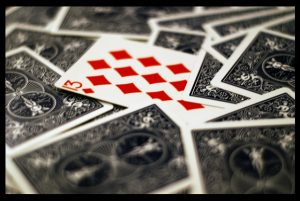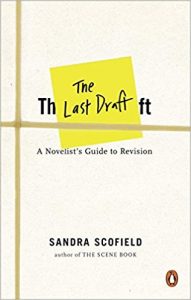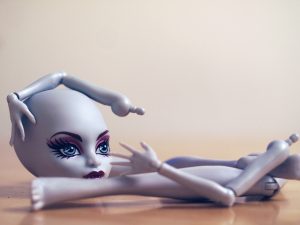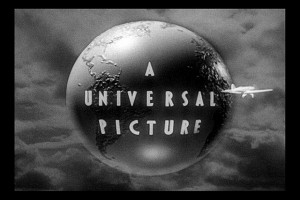Posts by Sarah McCoy
Flickr Creative Commons: Mohammed Alnasar
I visited Lucy Maud Montgomery’s bedroom on Prince Edward Island to research my forthcoming novel Marilla of Green Gables. Standing before Maud’s vanity mirror, I tried to see the world through her reflection: single bed, gabled ceiling, flower wallpaper, writing desk, lamp, chair, and window looking out to the Lake of Shining Waters. The morning light twinkled golden peach over everything in the room, and I understood why she protected her hours in it.
Montgomery wrote in the mornings, so the myth goes, and she always began with her journal. On February 11, 1910 she wrote, “… the worst as well as the best must be written out.” She had to first write herself out before she could begin the day’s fiction.
Was this a decisive routine to clear the deck for her characters? An unconscious habit born of her youth? Or a writing spell that she feared breaking? I can’t say for certain, but it got me thinking about the superstitious patterns of our writer tribe. Some we admit. Many we keep secret. But Writer Unboxed is a safe space of honesty and acceptance, so I’ll crack open my nut first…
In Montgomery’s room
I wear a cape when I write. Technically, it’s a red tartan robe that my mother gave me. My husband refers to it as the “get-off-my-lawn” old man robe. But he’s of a medical mind and doesn’t comprehend the magical realms of our craft. It’s a cape, endowed with super powers. I have a hard time concentrating when it isn’t on. I’ve tried to supplement with a sweatshirt or shawl, but I spend the whole time yearning for it without a single word produced. Also, when I’m not robed, it usually means that I’m in public attire. I.e. The public (my husband, mailman, dentist, doctor, friends and neighbors) feels within its right to interrupt me. My cape protects me from this—a kind of warm, invisible cloak allowing me to slip into the imaginary without distraction. Sure, one of the pockets ripped off and hangs to the side; the cuffs are permanently ink stained; the sash was knotted some time ago and with subsequent washings has become untie-able. It’s a homely thing. I’m a realist in that regard. But I’ve worn it every writing day of my last two books, and it has made the impossible happen many times. I fully intend to wear it until the seams come undone and the hem tatters.
I am not alone in my wardrobe particulars. Caroline Leavitt says she writes better when wearing a specific set of red earrings. Carson McCullers has a lucky sweater, and Francine Prose wears her husband’s red and black checked flannel pajamas. Then we have John Cheever who preferred nothing at all and wrote best in his underwear. Garments aside, there are many other superstitions to be claimed.
Isabelle Allende begins all her novels on the same day: January 8th. Truman Capote, Mark Twain, and Edith Wharton insisted on writing lying down. Lewis Carroll, Charles Dickens, and Hemingway had to be standing up. While A.J. Jacobs walks on a treadmill and Dan Brown hangs upside down to cure his […]
Read MoreSarah McCoy with Sandra Scofield
I first met Sandra Scofield over ten years ago. A visiting professor to my MFA program, Sandra was lauded for her unparalleled storytelling and a National Book Award Finalist (Beyond Deserving) as proof. To work with her, master students had to submit their stories and be accepted for one-on-one workshops. I had the great honor of being selected. I was working on my thesis, which would go on to be my first novel The Time It Snowed In Puerto Rico. At the time, however, I came to Sandra with only a handful of short stories set in 1960s Puerto Rico. She was loving but brutally honest in her critique. Her aim was not to foster her students’ egos. No participation trophies in Sandra’s satchel. The ultimate good of the story was paramount.
At the java shop that my fellow MFA-ers gathered, some lamented the criticism of our straightforward Montana mentor. But I’ve never been one for mollycoddling—giving or receiving. I took to the fierce twinkle in her editorial eye, and we forged a friendship through common understanding that it isn’t the author that earns praise or censure but the writing. It’s been over a decade now. I’ve lost touch with many of my MFA colleagues but my devotion to Sandra has only rooted deeper.
She came to visit me in Chicago last year. We had tea at the local indie bookstore, swapped stories, photos, laughs and books, of course. She shared her new novel Swim: Stories of the Sixties with me. The narrative mastery left me wonderstruck. So when she sent me the advanced copy of her new craft book (releasing December 5, 2017), I nearly tackled the mailman on delivery. St. Nick came early! And I was not disappointed.
The Last Draft is an invaluable guide to a novelists’ revision process. All the lessons I learned from Sandra for the last ten years are bow-tied and bound into this compelling resource. Author guru Janet Burroway (Writing Fiction) calls this “a needed book…” And I have every confidence it will be part of the creative writing canon.
So it is with great pleasure that I welcome Sandra to share her wisdoms with our Writer Unboxed community.
Read MoreIt’s been a strange August full of strange happenings.
It started when I packed up my gypsy wagon once more and moved from Chicago to North Carolina with an unintended pit stop (i.e. dead car battery) beside a nuclear power plant. Did I mention it was the dead of night in West Virginia with everything closed the following day? Soon after, Charlottesville, Virginia, was set upon by white supremacists. My husband is a UVA alumnus and we dated through our undergrad years, so I have a romantic devotion the town, its students, and community. It broke our hearts to see it tainted with hate and violence. Immediately following, the sun and moon aligned in the first solar eclipse in 99 years. All in a month.
Prophetic much? I came close to telling my builder to scrap the house plans and dig a bunker. Then I remembered that living in fear is exactly what our enemies want—whether they come from within (supremacists) or without (terrorists). We can let the internal and external devils govern our actions, or we can seek some semblance of understanding so as to respond discerningly. Words are our power, friends.
As men and women whose lives are dedicated to the craft, the responsibility falls on us to be facilitators of a positive language exchange. Antagonistic rhetoric is too readily accepted today, indirectly and directly. It’s become the only way many know how to communicate. But anger and fear only fuel the beast.
Make no mistake: we are angry; we are fearful. But as guardians and proprietors of words, we understand that there is grace, knowledge, and a defined intent to every written and spoken element. This is the credence we give to spending hours deliberating over each a and the that make up the sentences and paragraphs and pages of our chapters. Words matter.
Once expressed, words resonate through the chambers of the world we inhabit and through the chambers of ourselves. We believe them— believe in them. So we must choose wisely, now more than ever. This is not the time for ignorance or flagrant tweets. 140 characters have the power to unite or destroy a nation.
Let’s be clear about the truth of language: words see no color of skin, religious affiliation, age, or sex. They supersede time, wealth, and political powers. They are steadfast as the mountains yet fluid as water. Our sacred texts even refer to them with veneration: In the beginning was the Word… They are to be honored and applied with due diligence. Anything less twists their nature and makes them void.
Silence is not an option either. I’m ashamed to confess that I tried that in the past. During the volatile election year, I had a well-meaning family member counsel me not to publicly express my personal beliefs. She warned me that it would never reflect my true heart. I’m guilty of caving to the pressure. I didn’t want to offend family and friends on either side of the political divide.
Charlottesville changed me.
Read MoreA couple years ago in Tucson, I had the pleasure of sitting down to supper with a remarkable handful of author friends: Jean Kwok, Edan Lepucki, and Scott Turrow. We’d traveled across the miles for a book festival and had spent the day at our various speaking events. All were exhausted, slightly sweaty, and hungry, which lent both a familial and illusive vibe to our gathering.
The restaurant was western themed: colored lights had been strung between red pepper skeins; the walls were a rainbow of Mexican tiles; a giant Long Horn skull hung over the entrance. The building was a local icon and had once been the town’s signature hotel. We sat inside away from the patio crowd despite our knees banging into one another under the table. Intimate was the word we whispered. That didn’t bother us. Our waitress had an Annie Oakley drawl and was quick and skilled on the pours. Mariachi music played faintly from a jukebox.
I couldn’t tell you what we ate or drank, though I know we did because our table was full of empty dishes in the photos. While substantial, the meal wasn’t what filled us. The company did. For hours, we talked of our writing, our business, our loved ones, those we admire, and our dreams for the future. As storytellers, it’s important to listen, too. To stop supplying the narratives and allow our own creative cup to be replenished by others. I loved hearing how each friend came to write and publish and be; what they struggled with then and now; and most importantly, the path they saw ahead.
It’s an incredible gift for a writer to find a group of peers she both admires and trusts. I’d go so far as to say that it is an essential of being a progressive author— an author in progress—the art of communal learning.
Scott and Jean shared a piece of cake for dessert. I ate all the whipped cream off Edan’s chocolate mousse. We drank coffee and laughed until the place was about to close up. Scott, being the gentleman that he is, picked up the check, and we left. Writing quills blown to the four winds.
Since then, each of us has given birth to a new book. (In Edan’s case, a book and a baby!) So I thought this might be the perfect opportunity to get the gang back together. In spirit, I’m bumping elbows with Edan and spooning off her plate. Jean and Scott are across the table kicking our shins and lifting glasses. That’s the beauty of our craft and friendship: all we need do is write, and we are together again.
So pull up a chair, friends, the three questions on the virtual table are:
1) What did your first book teach you?
2) What is your current book teaching you?
3) What do you hope to have perfected by the end of your career?
Q1: What did your first book teach you?
JK: I was completely clueless when my debut novel took off. I was running behind, trying to figure things out like: how to tweet and how to unfreeze my face when someone took a photo of me. The public aspect of being an […]
Read MoreFlickr Creative Commons: Torbeln Ronning
I didn’t expect it, but changing publishing houses is like living in Mayberry your whole life and deciding to relocate to London. Potentially forever. You’re aware that it won’t be an easy transition, but you can’t imagine it’s that hard. People speak the same language where you’re going and historically, we were all once kinsmen.
Change is the essence of life. People do it every day. Even nature is perpetually evolving: winter, spring, summer, fall. So this should feel organic, right?
Not quite. I won’t sugarcoat the truth. This has been one of the most arduous journeys I’ve ever experienced. Nearly more difficult than getting my first book published—because then I was simply happy for an open door. I was content to have my novel be made real on bookshelves. I didn’t know anybody in publishing, and they didn’t know me. My publisher and I were new sweethearts, and I hardly edited a dozen words of my manuscript before it went to press.
Bless all the experienced authors who cheered and smiled and let me think it all so snappy. If I met my debut self right now, I’d pour her a stiff drink and say, “Girl… start taking that Zantac.”
Here’s something you need to know about me: I’m loyal to a fault. I fiercely defend my trusted relationships until I reach an absolute, indisputable end. I don’t know how to be any other way, personally or professionally. So I stayed at my original publishing house for nearly ten years while it and everyone in it changed.
I went through six or seven editors—so many I can’t even recall the exact count. They just kept leaving my imprint. And for those of you who’ve never had your editor leave in the middle of your book project, I think I can speak for the rest of us: it completely knocks you off your creative horse. Your writing legally belongs to the publishing house, not the editor employed by the house. So there you stay to be assigned to another in-house editor, who is usually inundated with projects already. Back to square one with the nice-to-meet-you’s, never mind the ins and outs of the book you’re working on. Do that 6-7 times and you feel like a redheaded stepchild. How could you not?
What many of you don’t know is that when my latest novel The Mapmaker’s Children released, my lovely editor left for another publishing house imprint, and I was assigned once more. This was the straw that broke the writer’s back. My agent and I agreed that I needed to move to a fresh house. Easier said than done. Here’s why…
Unlike with my debut, I know people now.
Read MoreFlickr Creative Commons: Randy Adams
We live in a culture and time of Listen to Me.
Listen, we preference our statements to family, friends, and strangers. Did you hear me? We ask when someone doesn’t do as we request. Can you hear me now? Can you hear me now? We jokingly parrot into our third ears (cell phones) and are piqued to shrieking if there’s a connection hiccup, a dim signal, a garbled word. But stop a minute. Hush yourself and think about it: if each of us is talking, how can the other ever be the listener?
I’m a storyteller. That’s my craft, my profession and my passion. Every hour of my life (wake to sleep) is dedicated to the business of stringing together words and telling a story. The odd paradox of being a writer is that it’s imperative that we be listeners first.
Seek to hear
Just this past week I was at the doctor’s office. My technician is from Poland. We’d had our introductory meeting last month when I moved to Chicago. Then, she’d asked me what I did for a living, and I told her I wrote books.
When I arrived for this second visit, she met me in the exam room, “I’m reading your book! The Time It Snowed In Puerto Rico!” She took a vacation to the island this summer and was interested in learning more. While she went about her medical checklist, she said she was fascinated by the similarities between my young protagonist’s dream of “making it to America” and her own growing up.
As it happened, I was physically in a position where I couldn’t do the talking—couldn’t tell her about my mom, titis and abuelita, about my family farm in Aibonito, about the food and the music and all the wonders of Puerto Rican culture. All the stuff that I’d grown accustomed to chatting about when someone brought up the book. So instead, I turned the tables on myself. I became the listener.
“Tell me about growing up in Poland, how you came to be in Chicago,” I said.
Read MoreFlickr Creative Commons: Alice
The packers are here. Yes, this very hour. We’re moving. Not down the road, across town, or even as close as a state away. We’re traveling 1,500 miles north to an entirely new place, another world for all intents and purposes. By this time next month, I’ll be there and not here. This present hour will be the shadowbox memory in my mind.
So while men stack my books in brown boxes and seal them up with packing tape, I’m standing here at my office window, looking out at the mighty Franklin Mountains and the parched Rio Grande. They’ve been my writing companions for nearly a decade. From here, I’ve watched the sunset light up that rocky ridge as red as a bonfire. I’ve felt the anxious anticipation of a summer sandstorm’s approach. I’ve opened this window to let in the rare scent of desert rain. I rooted my mind—reality and imagination—within the frame of this place.
Place. Such a powerful thing. A story world cannot be composed without first being grounded in a place and time. The setting is the stage on which the characters and action are invested.
Writers Roundtable
This topic of place came up in a group of novelists on Facebook. Aline Ohanesian explained, “With my first novel, I felt a string of personal connections to the place/setting of Central Anatolia where my grandparents were from. I grew up listening to stories about the old country until I felt nostalgia for a place I’d never been.”
Hilary Zaid was passionate that “place is inextricable, essential, and informs everything else. A novel is steeped in it, as an object in a vat of dye.”
Sandra Hunter agreed, “I’m with Hilary. For me, setting informs everything. It provides dimension to character, explains root causation, as well as conflict and just about every other thing.”
Going to my own work for evaluation, I find that the settings have always been the genesis. In The Mapmaker’s Children, the novel began with a West Virginia house hiding a secret. The culture and history of the Underground Railroad in that specific location was the catalyst for the characters’ journeys. The landscape (environmental to social) directly influenced the plot action.
I was led to write The Baker’s Daughter after moving to El Paso, Texas, and meeting a German woman selling baked goods at the farmer’s market. I knew Garmisch, Germany, having been there as a child and visited often as an adult. The two places are as significant as the characters that hail from them. They don’t align naturally and yet, they align authentically.
And right there, we circle back to Hunter’s comment: conflict in setting is story gold.
So now, I’m flipping the coin. If setting is such a forceful ingredient in our writing, wouldn’t it be equally potent in our real lives? We all agree it is the bedrock to our creative worlds, but what about our personal ones?
Read MoreFlickr Creative Commons: Craig Sunter
I’ve had paperbacks on my mind this month with the release of my third novel The Mapmaker’s Children in trade edition. One of my favorite things to do when on travel is to check out a city’s local antiquarian shop and quarry the shelves for forgotten book gems. All of which, I recently noted, were hardbacks. It makes logical sense that paperbacks would have a difficult time withstanding the wear, tear, and eras. After all, paper by its definition is made of organic materials—perishable like all of nature’s creations.
When I was very young, I found what I coined “the most perfect acorn in all the earth’s forests” behind our military barracks. We’d just moved from Germany where I’d heard tales of the sacred oak tree but lived in the city, so I never got to see the fabled oak seed before that day. It seemed a wondrous discovery. Firstly, it was very large—the width of a quarter, which by acorn standards is epic. Secondly, all the other acorns on the ground were cracked, misshapen, dirty, and half-eaten by forest critters. My acorn was pristine and shiny as if it’d been polished with butter. I carried that darling nut home and put it in my treasure box where it stayed faithfully for decades.
Married and about to move across the country to Texas, I took my childhood mementos from my parents. One of those being my treasure box. I wish I could say I opened it to find all my precious items as pristine as the day I collected them, but no. My acorn had been the victim of a long-ago bug feast. It was pocked with holes, cracked open, and brittle. I mourned for a beat then decided that the acorn had a very special life in my life. It hadn’t been ravaged by a toothy squirrel or been left to rot in the wet marshes. It’d been cared for and loved by a little girl who saw magic in the ordinary.
I assume we don’t find paperbacks from the early 1900s for precisely this reason: they are ephemeral. In truth, paperbacks are the titles passed from literal hand to hand; the books that bring readers together in groups to cry into, spill their coffees on, and swat away intruding summer gnats. They are the books of the everyday, right? Just as history only records the major events, the quiet routines are simply… lived until they are gone. But aren’t those the ultimate zeitgeist of a time? Being a history geek, I took to the archives for answers.
Read MoreI’ve been on the book tour road all month, so I never got to feel the “first day of autumn.” It was a scorching 104-degrees when I left El Paso. Since then, I’ve been bouncing between airplane terminals, Uber cars, and air-conditioned event venues. It could’ve been freezing or smoldering outdoors, but I hardly had a minute to register the state I was in (California? Tennessee?), never mind the temperature.
Fall and spring are my two favorite seasons—the tweeners when hot and cold helix into a strange fusion predicated on cloud shifts and shadow breezes. Change, vividly bestowed on all the senses. It makes me giddy. I want to open all the windows in my house, let in the happy ghosts, watch To Kill a Mockingbird, and light pumpkin spice candles. But I wasn’t able to do any of that this year. To completely miss fall? Well, it bummed me out.
By the time I’m home again, it’ll be the holiday season. All white wonderlands and wintry delights. So either I flew around the country with a witch’s scowl for missing Charlie Brown jack-o’-lanterns, baking apple pies, and handing out candy corn or I brought the merry trick-or-treat spirit with me. I decided on the latter and concocted a game to play with dear authors who met me on the book tour road.
I call it #ScareCareShare. Akin to trick-or-treat, truth-or-dare, or any of the make-a-choice diversions we used to play with school friends on crisp harvest nights.
Here are the super simple rules. The authors were asked to each pick one:
❖ SCARE (something that they’re afraid of)
❖ CARE (something that they’re passionate about—excluding books)
❖ SHARE (some sage piece of writerly advice)
I carried the #ScareCareShare journal with me to every city and passed it around fancy tearooms to candlelit, writer barbecues. It ended up being much more fun—and heartfelt— than I ever initially imagined. I cherish the handwritten entries of each of these wonderful authors. I must thank them for playing along and for embracing me with all the warmth of the season. Who needs Great Pumpkins when you have great friends like these…
Read MoreWhen it comes to professions, being a Writer is unique in that people often feel inspired to say to us whatever pops into their minds. From strangers at cocktail parties to long-standing relations, we’ve all been confronted with pretty odd parlays. What’s most bewildering is that those same people would never say such things upon meeting a doctor or sitting down to dine with a lawyer or even the kind old lady who makes their daily latte. They may wonder how much the doctor makes taking throat cultures; what illicit case the attorney has in hand; why a woman in her golden years would still be working at the coffee shop; but it’s common courtesy to respect those individual’s lives and vocations.
Enter the Writer, and all etiquette gloves are off.
I’ve had my painful share of experiences. One that never fails to arise at distant family gatherings is: “So Sarah, how are your books doing—are they selling?”
It seems innocent enough and yet, it’s a terribly uncomfortable question to put forth in the midst of carving the turkey. All other conversations shush and everyone waits to hear my response. I always come so close to answering, “Only to readers! Pass the salt.”
But see now, I would feel rude replying that way, even if it is the blatant truth that the individual ought to know intuitively after all these years. Then I wonder, would this relation continually ask a businessman, “So Joe, how’s your business doing—are you selling?”
Absolutely not.
[pullquote]It confounds me that those of us who work in creative careers are somehow seen as less “serious” than those in institutionalized jobs. We’re all making a living, paying the bills, following our passions, and leaving a mark on the world, right? So why, why, why do so many feel they are free to say rather uncouth things to writers?[/pullquote]
It confounds me that those of us who work in creative careers are somehow seen as less “serious” than those in institutionalized jobs. We’re all making a living, paying the bills, following our passions, and leaving a mark on the world, right? So why, why, why do so many feel they are free to say rather uncouth things to writers? The frustration appears to be shared.
This summer the hashtag #TenThingsNotToSayToAWriter went viral on Twitter. From celebrity authors to ghosting freelancers and everyone in between, Writers gave the world some friendly etiquette advice. I’ve gotten such a kick out of reading these. They’re so very Writer Unboxed that I asked a few friends for their experiences to add to the list. We can all learn from these, laugh together, and for some, take notes.
Read MoreEpiphany Part 1 arrived in my living room as my husband griped at another Turner Classic Movie marathon Friday night.
“But it’s Katharine Hepburn!” I balked. “One of the greatest character actors ever!”
I’m addicted to old movies. Black and whites make me swoon and don’t even get me started on Technicolor.
My husband merely shook his head. “I’ll never understand why you like these when it takes an act of God to get you to the theater for a new release.”
“Because these aren’t movies about surly Teddy bears or Tom Cruise sprinting from danger again,” I argued. “These are mini-time capsules. From the costumes and scenery to the plotlines and cultural messages— I’m gathering history details. Educational entertainment!”
And the second I said it, I realized, yes, that’s exactly it. It’s the same in my reading and writing. Not only am I a historical fiction devotee, but I also advocate for the past teaching us something in the present. My preference is for stories that make me think back about how it was, as a catalyst to change how it is. It’s why I write contemporary-historical dual narratives like my latest release The Mapmaker’s Children. I appreciate being entertained and educated without the didacticism of a classroom. I like feeling my time has been well invested in things that enrich my perspective and enable me to speak intelligently on a topic I may not have known prior.
This is why I yawn through Will Ferrell movies, despite liking him as an actor. And why I smuggle Venti Starbucks cups into the theater to make it through the latest Marvel Comics action-adventure. I need art to work a little harder than that for me to truly enjoy the experience. I know, I’m an awful demanding patron.
My imagination is much like my stomach. Everything I put into it influences its state of being. It craves hearty nutrition and aches at too much sugar. It has violent, allergic reactions to certain fare and appreciates recipes with a long tradition of excellence. Simply stated: I am what I put in me. And I prefer to put in Little Women with Katharine Hepburn.
Epiphany Part 2. While watching above mentioned classic film on my couch, I was multitasking: working on a requested playlist of songs related to The Mapmaker’s Children for a blog. I was struggling on compiling contemporary songs (i.e. I just kept humming “Swing Low, Sweet Chariot”). I don’t listen to music while I write. I’m one of those “black hole” writers. No music, no phones, no sound. So I can hear every heartbeat of my characters, every note they want to sing.
However, I realized then that something else had become a staple of my creative process: watching old films at night when my brain was too tired to wordsmith anymore. They are my soundtracks—my quasi-playlist of inspiration. In a snap, I had list of movies I watched multiple times over the three years of writing The Mapmaker’s Children. Without being conscious of it, I’d studied these films: the backdrops, the character portrayals, the cultural attitudes they sought to evoke, and the ones that permeated with and without intention. Even in […]
Read MoreHow’s that for a title? But then, it’s not really a title so much as a statement of fact, a warning perhaps, that this post may be complete higgledy-piggledy, self-absorbed author neurosis. I had every intention of not subjecting you, great reader minds and esteemed unboxed writers, to the behind-the-curtains peek at my obsessive underoos. I had an entirely different blog charted out: a composed, erudite, literate essay on my three years of fictional archaeology while crafting the dual narratives of my forthcoming novel The Mapmaker’s Children.
But when I sat down at my computer to write, all I could think was, “Bollox, my book is coming out in a flippin’ week!” That’s 7 days, 168 hours, or 10,080 minutes, depending on your level of countdown compulsion. (I’ll let you guess what my craze-o-meter is set at.) I beat my knuckles against my keyboard for a few hours attempting to thump into existence the aforementioned essay when it dawned on me: This is Writer Unboxed. I am the definition of a writer come completely unboxed! So I’m giving it to you uncensored.
I would place the week before an author’s book publishes up there with weddings, house moves, and child births in the top most stressful events in an individual’s life. Why? Because the author has just spent God knows how long (4 years from idea to shelf for The Mapmaker’s Children) nurturing relationships in a story world, carrying the weight of the characters everywhere she goes, and feeling each kick and heartburn of the book’s gestational development. So in that sense, when release day finally arrives, she is the celebratory bride, the moving man, and the doting mother all in one. Sure, there are those who might find each of those singly enticing, but all three simultaneously? That’s a maelstrom of anxiety.
[pullquote]Publishing a book is like giving the world sudden X-ray vision. Everyone sees my inner bits and is invited to judge them.[/pullquote]
Being writers, there is also a general proclivity toward being an introvert. The spotlight is not our preferred modus operandi. I champion my quiet nest, my home comforts, my hours of makeup-less pajama parties of one. Publishing a book is like giving the world sudden X-ray vision. Everyone sees my inner bits and is invited to judge them. That’s the very nature of our business. A book is not merely a collection of words bound together in paper and glue. It’s an author extending herself to the universal reader population saying, “Here—I give you my creation. Please come, walk the streets I’ve created in this imaginary realm. Discover its nooks and crannies. Solve the mysteries. Love and/or hate its people. Love and/or hate the story. Love and/or hate me.”
Read MoreI grew up on game shows. Jeopardy. Wheel of Fortune. Family Feud. The Dating Game. My favorites were the celebrity editions where we, Jane and John Does, sitting on our couches across America got to see famous people unscripted. To laugh alongside them like we were all a bunch of friends having pizza and soda round the game table. My husband and I still tune into Jeopardy, shouting out the answers before any of the players have buzzed. Game shows of every variety equalize the millionaire actor and the street vendor under the banner of “contestants.” A person’s past or even how they arrived on the show is inconsequential. All that matters is the present.
That accessibility to the masses and acceptance of the character game rules are attributes shared by literature. It’s why, as readers and writers, we get excited seeing a particular book we’ve read in the hands of a Hollywood star, political leader, or other esteemed person. We feel, “Me, too!” even if we don’t consciously think or say it.
So I went on a social media hunt for the current popular sport and found this all-inclusive gem: Shag, Marry, Kill. It seems everyone from superstar chefs to decorous journalists are being put on the spot to play. Well, I said to myself, why not authors in a literary edition—this is Writer Unboxed! I snagged three kind friends who were ready to get their game on.
(Ahem, stepping onto the game show hostess podium now.)
It is my pleasure to introduce brilliant writers and our distinguished contestants of the first Writer Unboxed Shag, Marry, Kill column:
Megan Abbott, Edgar-winning author of the novels Queenpin, The Song Is You, Die a Little, Bury Me Deep, The End of Everything, Dare Me, and her latest chosen as best book of 2014 by Amazon, The Fever.
Melanie Benjamin, New York Times bestselling author of The Aviator’s Wife, Alice I Have Been and The Autobiography of Mrs. Tom Thumb.
Matthew Dicks, author of the critically-acclaimed novels Memoirs of an Imaginary Friend, Something Missing, Unexpectedly, Milo and the forthcoming The Perfect Comeback of Caroline Jacobs (September 2015).
The rules are simple: For each question, the contestant must designate which of the three persons he or she would rather shag, marry, and kill. It’s generally hard to say, I’ll shag X, marry Y, and kill Z without some kind of explanation and therein lies our entertainment. The story of why each “shag, marry and kill” were chosen.
Read MoreMy husband can testify I am a horrible road trip wing woman. Put a contemporary map in my hand, and I’ll turn it topsy-turvy before I can decipher anything of travel assistance. The road names, byways, mile markers, and intersections all blend into a flurry of ‘huh?’ God forbid he ask me where the nearest gas station or fast-food joint might be. My traditional response: “Get off the interstate and we’ll look around.” We had a tent revival halleluiah when we got our first GPS system. But this isn’t to say I don’t like maps. Quite the contrary. I’m obsessed with them. They tickle my brain to think hard—harder.
I love that you can take a road map, strip it of boundaries, concrete highways, interstates, and exit numbers; show me the topography of the land, the rivers and streams, mountain ranges and valleys, and suddenly, the world rises up off the page in vivid sensations: rocky, wet, and smelling of basin swamps and mountain air. It unspools —north, south, east, west. Each compass needle pointing to a story.
I’m particularly drawn to old maps. Visual atlases of how things were and are no more. The major road once connecting A to B is now gone. The major river once separating communities dried up fifty years back. Hilltops are laid low by our human wear and tear. Chunks of the earth are apportioned into territories/countries/states then divided further. Wars shred the landscape, bearing something new—not worse or better necessarily. Just changed.
And all the secret understanding is tucked into the mapmaker’s key (also called the ‘mapmaker’s legend’) at the bottom of the page, outside the plotted world; so if the journeyman is confused by the exact distance, surface, or body of water out of sight, the key will provide meaning. It’s a skill and an art: mapmaking.
Read More- « Previous
- 1
- 2
- 3
- Next »




















